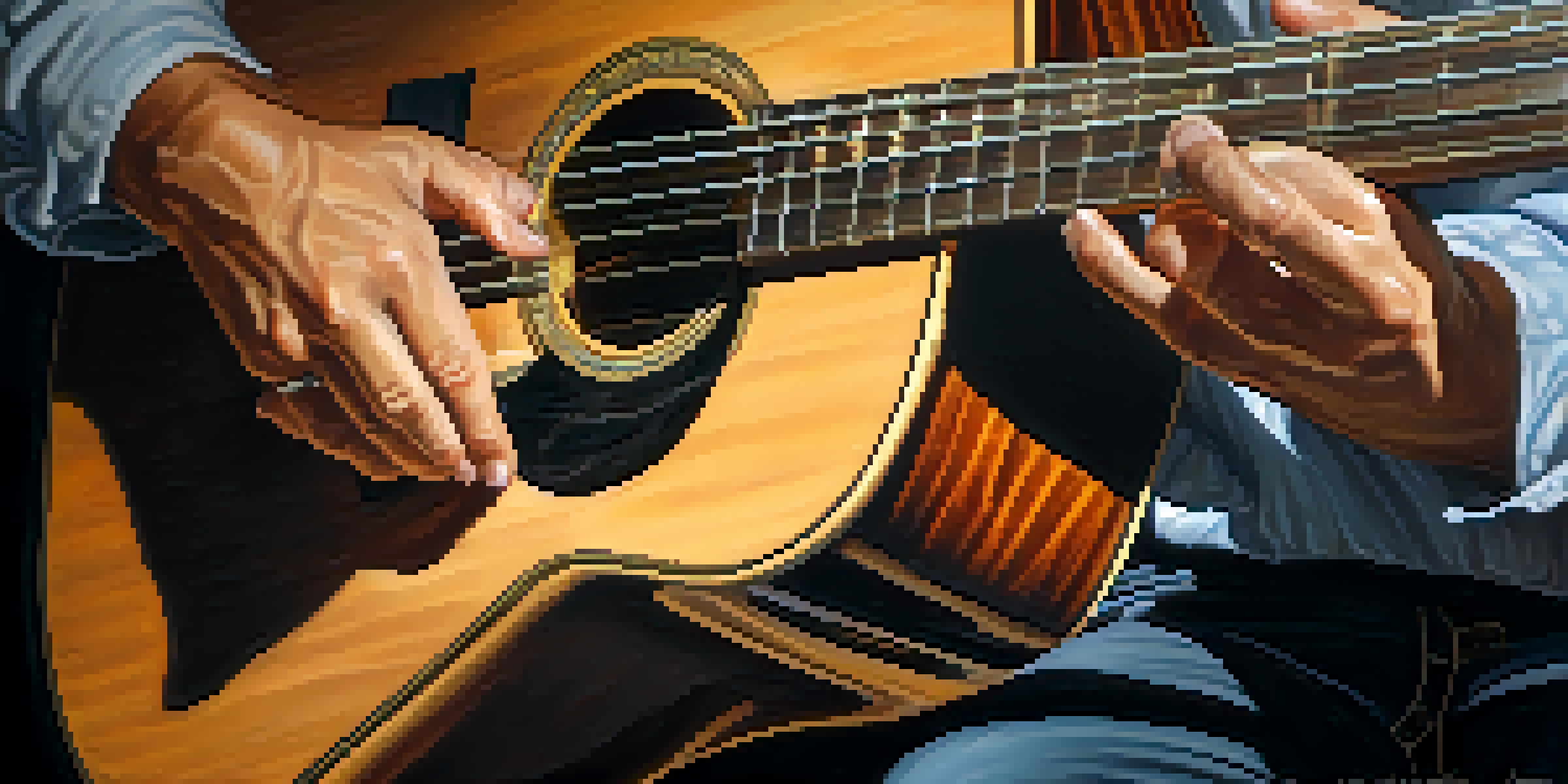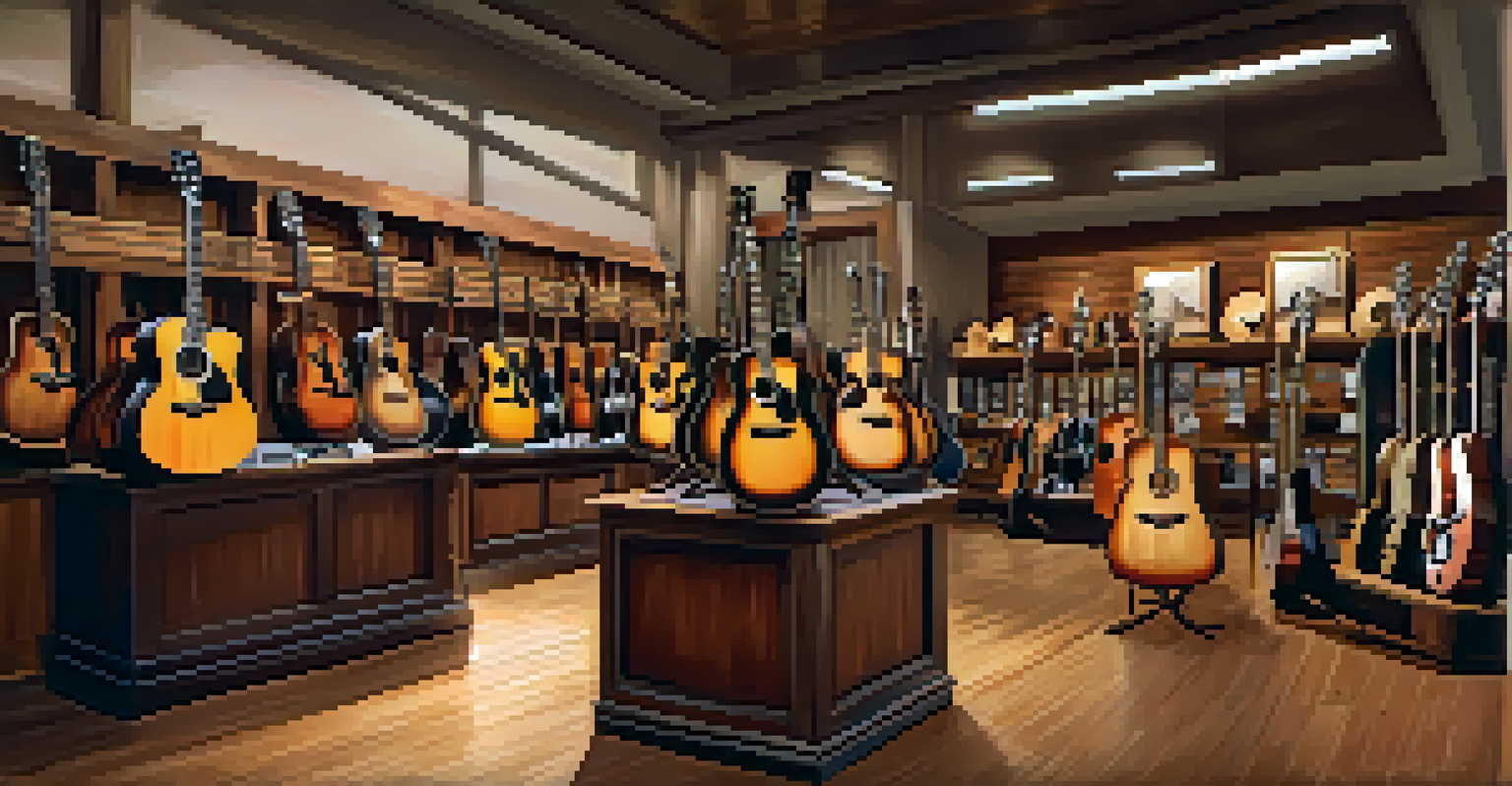Mastering the Art of Fingerstyle Guitar for Better Performance

Understanding Fingerstyle Guitar Basics
Fingerstyle guitar is a technique where you pluck the strings with your fingers rather than using a pick. This allows for a more intricate sound and greater expression in your music. It's essential to start by familiarizing yourself with the basic finger positions and string numbers to create a solid foundation.
The guitar is a miniature orchestra in itself.
Unlike strumming, where you may use a single motion, fingerstyle lets you play multiple notes simultaneously. This opens up a world of possibilities for creating melodies and harmonies. Think of it like painting a picture; each finger acts as a different brush, adding depth and texture to your musical canvas.
Once you're comfortable with the basics, practice simple fingerpicking patterns. Start slow and gradually increase your speed as you become more confident. Remember, mastering fingerstyle guitar is a journey, and patience is key in developing your skills.
Choosing the Right Guitar for Fingerstyle
Selecting the right guitar can significantly impact your fingerstyle playing. Acoustic guitars, particularly those with a wider neck, are often favored for fingerstyle techniques. This design allows for more space between strings, making it easier to pluck individual notes without accidentally hitting others.

The type of wood used in the guitar also plays a role in its sound quality. For instance, spruce tops are known for their bright tone, while mahogany delivers a warmer sound. It’s a bit like choosing the right ingredients for a recipe; the better your guitar, the richer your musical flavor will be.
Master the Basics of Fingerstyle
Building a strong foundation with finger positions and simple patterns is essential for effective fingerstyle guitar playing.
Ultimately, the best guitar for you is one that feels comfortable and inspires you to play. Spend time in music stores trying out different models until you find the one that feels like an extension of yourself. Remember, a confident player creates a more enjoyable performance.
Developing Finger Independence and Strength
A key aspect of mastering fingerstyle guitar is developing finger independence. This means each finger should be able to move freely and efficiently without affecting the others. One way to build this skill is through dedicated finger exercises that isolate each finger’s movement.
Music can change the world because it can change people.
Consider practicing with simple exercises like the classic 'CAGED' system, where you focus on different chords while using specific fingers. This will not only strengthen your fingers but also help in muscle memory as you transition between chords smoothly. Think of it as training for a sport; the more you practice, the more adept you become.
Additionally, integrating scales into your fingerstyle practice can enhance your dexterity. Scales are like the building blocks of music. As you play them with varied finger patterns, you’ll notice an improvement in both your technique and your overall musicality.
Mastering Fingerpicking Patterns and Techniques
Fingerpicking patterns are the heartbeat of fingerstyle guitar. They can vary widely, from simple arpeggios to complex syncopated rhythms. Start by learning common patterns, such as the Travis picking style, which features alternating bass notes and melody lines, creating a full-bodied sound.
As you become comfortable with basic patterns, challenge yourself by experimenting with different styles and tempos. This is where your creativity can really shine; think of it as adding spices to a dish. Just like a chef, you can mix and match to find a flavor that resonates with you.
Choose the Right Guitar
Selecting an acoustic guitar that feels comfortable and suits your fingerstyle needs can greatly enhance your playing experience.
Don’t shy away from incorporating fingerstyle techniques into your favorite songs. This not only makes the music your own but also enhances your performance skills. After all, music is about expression, and fingerstyle can add a personal touch that captivates your audience.
The Role of Dynamics in Fingerstyle Playing
Dynamics refer to the volume of sound in music and play a crucial role in fingerstyle guitar. Learning to control your dynamics can elevate your performance from good to great. Practice playing the same piece at varying volumes, focusing on how it changes the feel and emotion of the piece.
Think of dynamics as the shading in a drawing; it adds depth and interest. For instance, playing softly can evoke a sense of intimacy, while a louder passage can create excitement and energy. By mastering dynamics, you bring your music to life, making it resonate with your audience.
To effectively incorporate dynamics, listen closely to recordings of great fingerstyle guitarists. Notice how they use volume variation to enhance their storytelling through music. By emulating these techniques, you can develop your own unique style that engages listeners.
Incorporating Techniques from Other Genres
One of the exciting aspects of fingerstyle guitar is its versatility. By incorporating techniques from other genres, like jazz or classical, you can enrich your fingerstyle repertoire. For example, jazz chords can add a lush harmonic texture, while classical techniques can provide intricate melodies.
Think of it as mixing colors on a palette; each genre brings its own shade to the music. Many fingerstyle guitarists successfully blend these styles, creating a unique sound that captures the essence of multiple influences. Exploring different genres can inspire your creativity and expand your musical horizons.
Practice Mindfully for Progress
Focusing on specific techniques and setting clear goals during practice sessions leads to consistent improvement in fingerstyle guitar skills.
Don’t hesitate to experiment with different techniques and styles. Whether it’s adding a flamenco strum or a bluesy bend, these elements can breathe new life into your playing. Embrace the journey of exploration—each new technique is a step toward mastering the art of fingerstyle guitar.
Practicing Mindfully for Consistent Improvement
Mindful practice is the secret sauce to mastering fingerstyle guitar. Rather than mindlessly repeating the same pieces, focus on specific techniques and areas that need improvement. Set clear goals for each practice session, and take the time to reflect on your progress.
Consider using tools like a metronome to develop your timing and rhythm. Practicing slowly at first can help you play more accurately before gradually increasing your speed. It’s akin to building a house; a strong foundation is crucial for a sturdy structure.

Additionally, record yourself playing to track your progress over time. Listening back can provide valuable insights into areas that need work and celebrate your successes. Remember, mastery comes with patience and consistent, mindful effort.